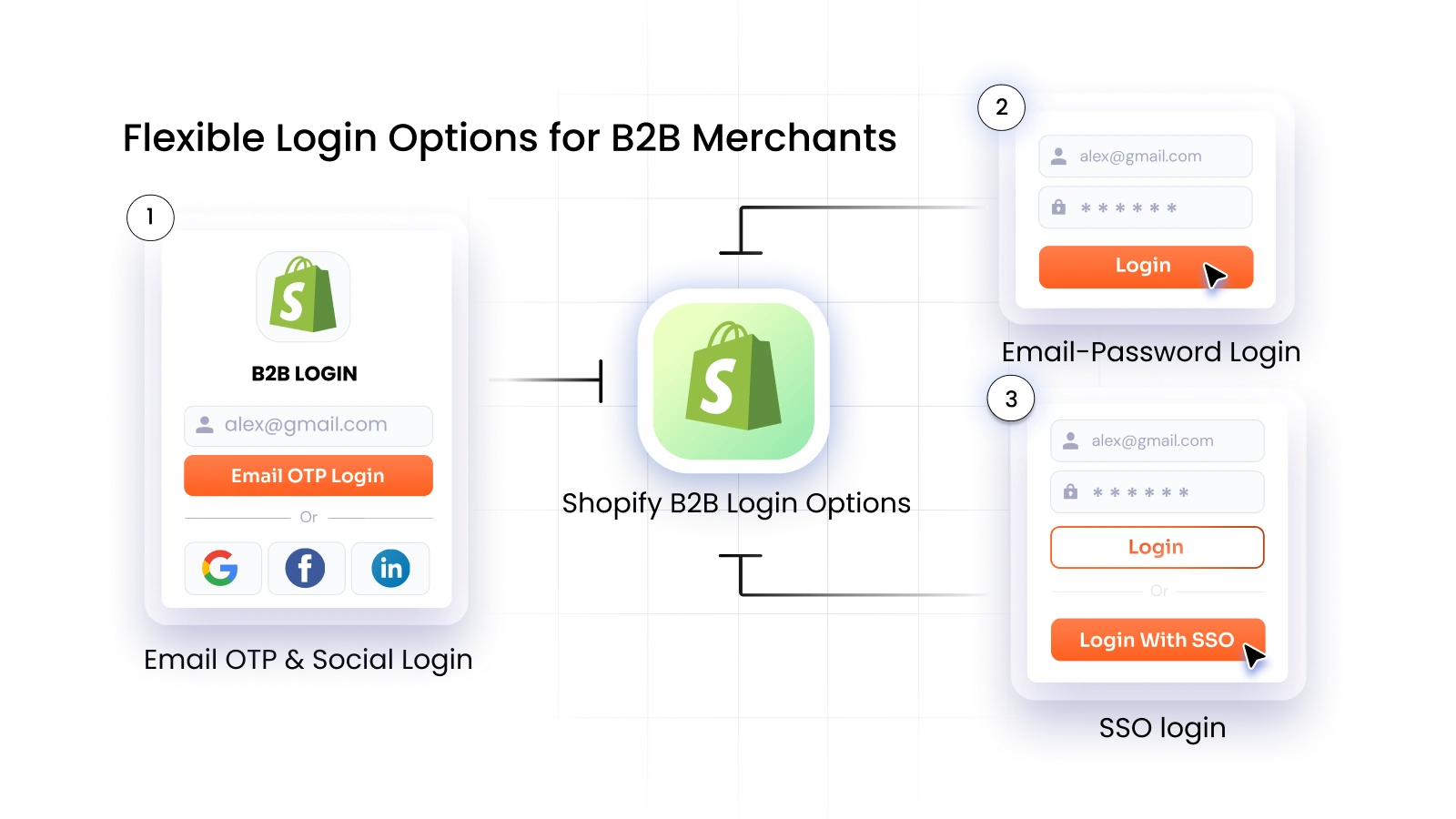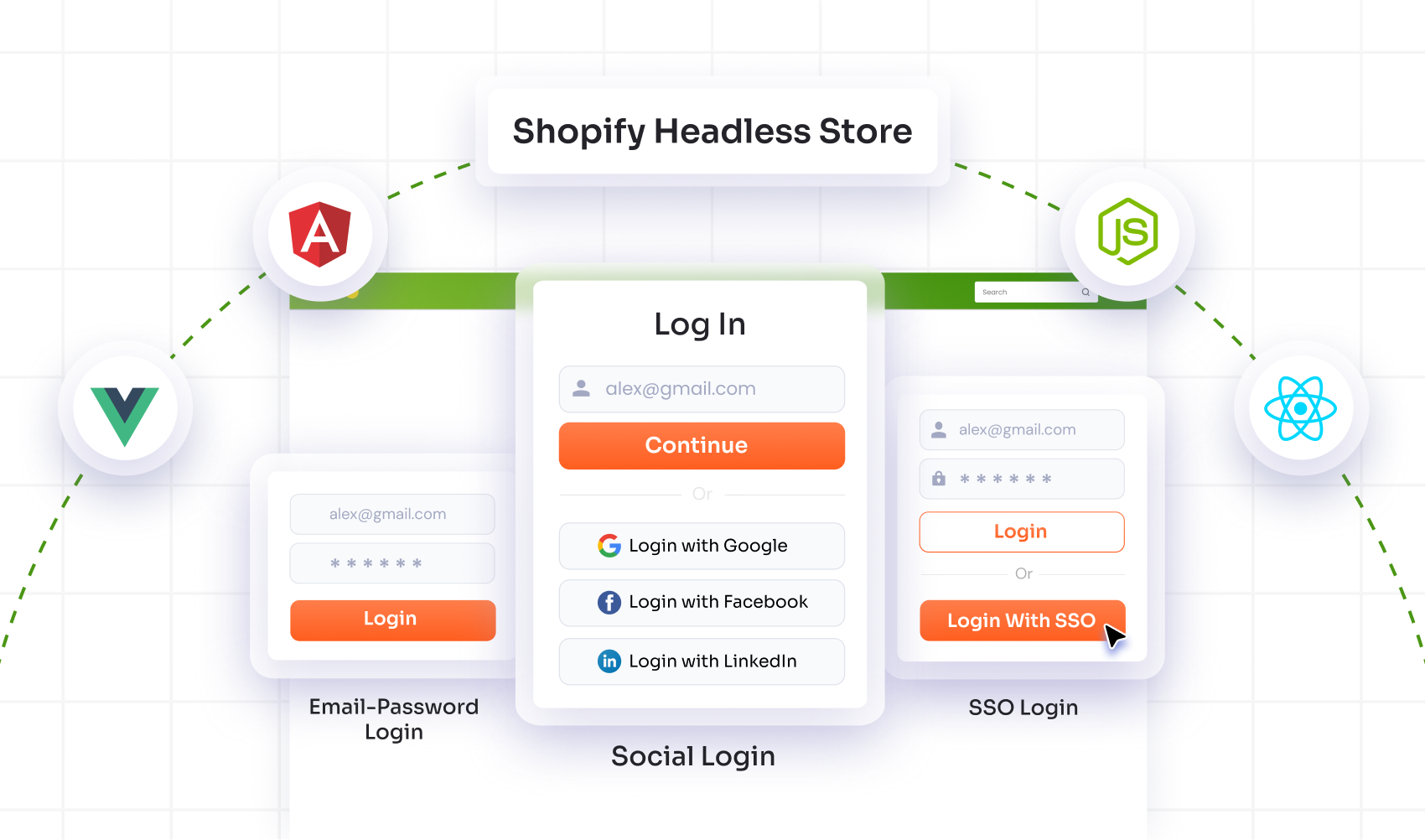Overview
Shopify’s introduction of advanced B2B features through Customer Accounts marks a significant step toward modernizing wholesale ecommerce. These updates aim to provide a more scalable and self-service-friendly experience for buyers. But while this is a promising start, there are also limitations around authentication, login methods, and access control that Shopify B2B merchants cannot ignore.
Why Merchants Are Seeking Flexibility From Shopify B2B Login
One of the ways the new updates from Shopify are benefiting B2B setups is by making the login experience simpler. The default Shopify B2B flow includes a simplified, email OTP-based login, i.e. passwordless access; ideal for merchants that are just getting started.
However, like any other emerging technology, there are some bottlenecks. As businesses scale and their operations become more complex, B2B merchants have started to identify certain limitations in the Shopify customer accounts login experience. What starts as a streamlined login flow becomes a point of friction when complex use cases such as shared-user access, role-based authorizations, auto-login from third party services, etc., emerge.
In this blog, we will explore the key challenges with email OTP-based login in Shopify B2B based on our observations and real-world feedback from our B2B customers. We'll highlight the specific issues that B2B stores face and learn how to move beyond them by bypassing the Shopify customer accounts login with flexible and secure authentication solutions.
What Are The Limitations & Problems Faced By Merchants During Shopify B2B Login?
1. Accessing Shopify B2B Store With Shared Email Account Access
One of the most common concerns raised by Shopify B2B merchants is having to manage Shopify B2B OTP login for shared user logins. In its current setup, Shopify requires every login to be verified via a one-time passcode sent to the registered email ID. But, what if in an organization, one email account is used by many users?
This is fine for businesses that are just starting out in the B2B space or have smaller teams. However, for merchants with larger internal teams or shared business emails, the Shopify B2B OTP login for shared users becomes problematic.
In this setup, every login attempt requires coordination with the inbox owner, presenting a limitation of shared logins in Shopify B2B environments.
To address this, merchants in this situation are actively seeking ways to bypass default email OTP login in Shopify B2B, in order to manage access for multiple internal stakeholders without unnecessary bottlenecks.
2. Login Redundancy Due To Email OTP-Based B2B Login
Imagine a scenario where employees are required to have access to multiple internal systems in their company, including Shopify stores. While they can log in using their corporate credentials in all the internal connected platforms, for Shopify, they are forced to log in via email OTP when they try to access Shopify B2B stores instead of auto-login. This repetitive step can cause delays and inconvenience for customers, causing disruptions to the workflow.
Also, the lack of fine-grained access control has led B2B businesses to seek more secure alternatives for auto-login by bypassing the Shopify customer account login, including ways to restrict access to specific user groups, based on customer tags, additional profile details, domains, or internal policies that are defined in their corporate Identity and Access Management Services.
This highlights a critical concern for B2B merchants, especially in industries that demand high security, such as healthcare, legal, or B2B finance.
3. Lack of 2FA Options For Secure Authentication in Default B2B Login
Some merchants have expressed concerns about the limited support for advanced authentication options like 2FA in the default Shopify B2B login flow.
For many B2B businesses, especially in high-security industries, enforcing two-factor authentication and similar options is necessary for securing access and store management. However, since Shopify’s default login flow relies on a single-step email OTP login, merchants are worried about the limited options for authentication, highlighting a key limitation of Shopify B2B login.
Shopify B2B users have therefore expressed their intention to disable OTP login for Shopify B2B customers and implement more robust authentication flows that are better aligned with their specific security needs.
4. No Customization Options for Shopify B2B Email OTP Login Page
Recently, B2B merchants switching to Shopify Customer Accounts have reported an important issue—the inability to customize Shopify’s default email OTP login page. In the current setup, there are no options to alter the branding, language, or additional input fields on the login page for Shopify B2B, making it difficult for merchants to align their login experience with their brand’s needs.
This issue is creating significant disruptions in the customer journeys, particularly for B2B buyers who expect a tailored and consistent login process that aligns with their experience with the brand.
This has made bypassing the Shopify customer accounts login a major concern for Shopify merchants in order to deliver a more customized and streamlined login flow for B2B users on Shopify.
5. Lack of Phone-Based OTP Login for Shopify B2B
The absence of phone-based OTP options has also been brought up as a notable limitation in Shopify customer accounts login. Currently, Shopify has made it mandatory for users to log in using email-based OTPs, with no options to verify users via their phone numbers.
This has become a challenge for B2B businesses whose customers either don’t have access to email, or who prefer to use SMS or other delivery methods that need phone numbers for authentication.
Due to this issue, many merchants are now exploring more flexible and accessible login solutions that allow them to bypass default email OTP login in Shopify B2B and give customers the option to log in using their phone numbers instead.
6. No Post-Login Redirect Control
Another common issue reported by B2B merchants is the inability to control where users end up after they log in. In the current flow, users are redirected to a default page on the B2B login portal, even if they want to navigate to a different page.
This is a major concern for Shopify B2B merchants who wish to offer smooth and tailored experiences. They are actively looking for an alternative that would help them avoid email OTP in Shopify B2B login altogether and route users to specific pages (product pages, orders page, etc.) automatically once they are logged in.
How miniOrange Helps to Overcome the Limitations of Shopify Customer Accounts Login?
Based on these observations and the queries from several Shopify merchants, it has become clear that there are some distinct limitations of Shopify customer accounts login for B2B setups. Our Shopify Single Sign-On (SSO) solution is built to address these specific challenges and help disable OTP login in Shopify B2B to make the process more flexible, secure, and better suited for real-world workflows.
The Shopify SSO application provides a login flow that works using the users’ existing credentials, eliminating the dependency on email-based OTPs. This is a crucial step for merchants that are looking to bypass OTP verification in Shopify B2B, especially in shared-access environments or among larger teams where bottlenecks like OTP are likely to occur.
The solution also offers support for Shopify B2B custom user login forms, hosted on Shopify or other third-party platforms. By allowing merchants to login new users through a custom registration form in Shopify B2B, Shopify SSO provides greater control over which users are allowed to access the store.
miniOrange also offers an alternative solution to Shopify Plus stores looking to bypass the default email OTP login in Shopify B2B. Our passwordless login solutions for Shopify B2B are especially useful for users who prefer not to use email-based credentials to log into the store, allowing them to authenticate using an OTP sent to their mobile phone number instead. Passwordless login is a secure and convenient way to disable OTP login for Shopify B2B customers who need flexible access options beyond email.
For the email OTP-based login for Shopify Plus B2B stores, using passwordless login solutions, these can be useful for those users that do not have email based credentials, by allowing them to receive an OTP on their mobile phone number instead of logging into the store.
Ultimately, by enabling merchants to disable OTP login in Shopify B2B, the Shopify SSO solution delivers a scalable, real-world answer to the accessibility challenges faced by B2B merchants.
Frequently Asked Questions (FAQs)
Can you disable OTP login in Shopify B2B?
Yes, while Shopify’s default settings do not support disabling OTP login for Shopify B2B customers, merchants looking to avoid email verification bottlenecks and manage login for multiple staff in Shopify B2B can consider implementing a secure login flow that uses the existing Shopify credentials to give users access to the store.
Is there a way to bypass default Shopify B2B OTP login?
Yes, some solutions like Single Sign-On allow merchants to avoid email OTP in Shopify B2B login entirely. By authenticating users based on their existing Shopify credentials rather than email-based OTPs, businesses can overcome the limitations of Shopify customer accounts login and create a smoother, more scalable B2B login experience.
Are there any Shopify apps that improve B2B login flow?
Yes, miniOrange offers a Shopify SSO application that helps merchants bypass OTP verification in Shopify B2B, support login of new users through custom registration forms, and creates a more flexible login experience tailored to real-world B2B needs.
Conclusion
While Shopify B2B via Customer Accounts is a great starting point for Shopify to address the needs of merchants, real-world feedback suggests that there are still certain limitations of Shopify B2B login that need to be addressed.
B2B ecommerce is evolving constantly, and it is essential for merchants to adapt accordingly. In this scenario, solutions like Shopify Single Sign-On from miniOrange will play a key role —addressing pain points from team access issues to login loops—so that B2B merchants can focus on scaling their business without disruptions.
Any of these issues resonate with you? Connect with us to explore how you can simplify your B2B login experience.





Leave a Comment